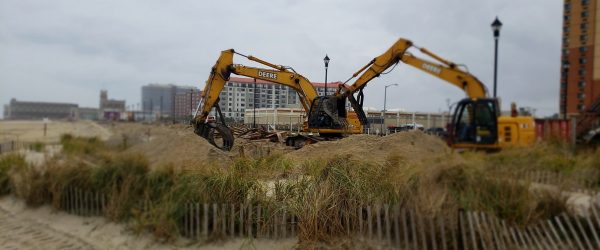iStar North End Infrastructure Improvement Project Draws Environmental Concerns
Close To 2K Support Save Asbury's Waterfront Petition To Stop Boardwalk & Parking Lot Redevelopment Project
Environmental concerns along Asbury Park’s waterfront have taken center stage once again.
A recently launched north end infrastructure improvement project by iStar – the city’s master waterfront redeveloper, resulted in the Friday morning launch of a petition to halt the redevelopment.
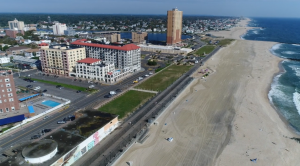 Save Asbury Park, the grassroots group behind the fight to preserve a swath of land commonly known as Bradley Cove, garnered 218 supporters within 7 hours of its Save Asbury’s Waterfront Change.org petition. By Sunday morning the number grew to over 1,200, ballooning to close to 2,000 by Monday afternoon.
Save Asbury Park, the grassroots group behind the fight to preserve a swath of land commonly known as Bradley Cove, garnered 218 supporters within 7 hours of its Save Asbury’s Waterfront Change.org petition. By Sunday morning the number grew to over 1,200, ballooning to close to 2,000 by Monday afternoon.
According to organizers, the petition aims to ‘foster and encourage appropriate development along Asbury Park’s waterfront’ that will:
Maximize social inclusion and provide access for all residents and visitors
Recognize current coastal development guidelines and practices
Be sensitive to endangered species, pollution and other environmental concerns
Be transparent during all phases of planning and implementation
“We want iStar to immediately stop its ongoing construction that is based on outdated plans approved in 2004,” petitioner Kathleen Mumma [at right] said during a Sunday morning Asbury Park Homeowner’s Association meeting held at The Complex. “Asbury Park has undergone tremendous change in 15 years and iStar’s current development initiatives on the north end no longer suits our City. Instead of developing one of the largest remaining coastal open spaces in Monmouth County, we want iStar to use its innovation and vast resources to develop an appropriate, forward-looking plan for Asbury’s Waterfront.”
Mumma said the project will have an adverse effect on the ‘fragile, changing coastal environment, destroy the habitat of three threatened species, discourage public enjoyment of the waterfront, and does not support diversity and inclusion.
But iStar’s goal, says Senior Vice President of Land and Development Brian Cheripka, is to rehabilitate the area in an environmentally sound way for the entire community.
“There’s a lot of misinformation in the community about the improvements that are taking place,” Cheripka said. “We’ve tried to identify long term solutions for the community and how we deliver these obligations in the waterfront area. I think misinformation hurts all of us. I think these infrastructure improvements will be a tremendous benefit to the community.”
First envisioned and laid out in the waterfront redevelopment plan [WRP], the infrastructure improvement project calls for the north end boardwalk replacement from Sixth Avenue to what is commonly known as Fisherman’s parking lot, which also gets shifted north and paved.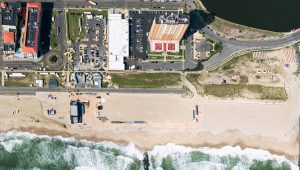
“The improvements are part of a larger, thoughtful redesign of the north end envisioned more than 15 years ago,” Cheripka said. “We accelerated the infrastructure improvement because this is just something we can do along the way.
Cheripika said although iStar donated $40,000 in 2010 for the temporary replacement of the pine boards, they were showing signs of aging.
“You couldn’t roll a wheelchair down that boardwalk,” he said. “In a very short period of time these things need to be replaced.”
iStar is investing $6 million to complete the public improvement project, which will be paid back via redevelopment area bonds supported by new homeowners in their waterfront homes.
“There is no cost to existing residents, who will get to utilize the new boardwalk by summer 2019,” he said.
A holistic approach was taken, particularly when it comes to environmental concerns, Cheripka said. The project, now in the demolition phase, was approved twice this year by the State’s Division of Environmental Protection’s CAFRA division, responsible for vetting development along the coastline. Based on discussions with the state agency, Cheripka said project details were updated to current ‘best practice’ standards.
“Part of our goal is to preserve the beach,” he said.
One example is the 1.83 acres of protective sand dunes that will feature 19,000 Cape American Beach Grass plugs and 2,200 indigenous grasses, shrubs and flowers along a 15 feet wide boardwalk, Cheripka said. The dunes will extend about 40’ from the edge of the new boardwalk on the east and 50’ to the west.
Cheripka said the at-grade sand dunes are not meant to preclude anyone’s view of the waterfront but as a environmentally sound practice now underway along coastal regions.
“Several years ago [2014], the federally-funded ‘Rebuild by Design’ competition recommended a meandering boardwalk/dune system in the North Shore area as one of three projects to make Asbury Park more resilient,” he said. “It also discussed the importance of the dunes in protecting the wastewater treatment plant. Even though the WRP and CAFRA permit pre-date Sandy, the original plan was forward-thinking in that it included a resiliency concept that [the HUD program] eventually recommended.”
iStar also opted to upgrade the parking lot stormwater management system from what was a permissible 50 percent catch performance rate to a model that will capture 80 percent of solids. The upgrade comes at a cost of up to $75,000, Cheripka said.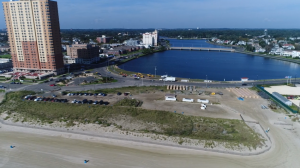
“These are things that will protect the environment,” he said. “The new, naturalistic dunes and grasses will offer significant protection from the destructive wave action and potential flooding associated with heavy storm events. In addition, the improved stormwater management system will help improve resiliency.”
As for the new 15 foot wide meandering boardwalk [at-grade with the new dunes], it is aimed at promoting a quieter neighborhood feel where North Beach and the senior Asbury Towers exists, Cheripka said. The master redeveloper has proposed a composite decking as a substitute for the pine boards, which requires an estimated $200,000 replacement every few years due to cupping.
“The composite decking will prevent splinter injuries and reduce liability for the City,” Cheripka said.
And, in response to the public’s concerns over the bench removals, Cheripka said they will return all 54 located north of Sixth Avenue, with some being placed on projected small areas so as to not impede the new 15 f00t wide boardwalk.
“We view this as a proactive measure in accordance to plan,” Cheripka said. “Good stormwater management and storm resiliency is simply good planning.”
In its totality, the boardwalk project will consist of: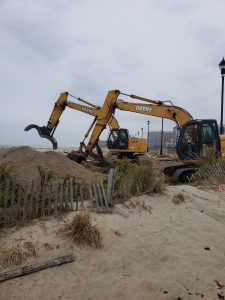
Adding one block of boardwalk to the north [where none currently exists]
Connecting to the new Fisherman’s parking lot area, which is being moved slightly north
The proposed composite decking, which comes with a 10 year warranty
Approximately 80,000 square feet [1.83 acres] of new protective sand dunes
And, as requested by the City Council in June, the boardwalk will keep its 64’ width between Sixth and Seventh avenues
Approximately 19,000 native Cape American Beachgrasses will be planted in the dunes plus an additional 2,200 native grasses, shrubs and flowers
All existing sidewalk to boardwalk access points will be reconstructed, with a new access point added on the southern side of Seventh Avenue and additional handicapped accessible entrances
The existing playground on the beach will be relocated approximately 200 feet to the north to accommodate the new boardwalk construction
As for the Fisherman’s Parking Lot improvements, Cheripka said they chose impervious material based on discussions with, and recommendations from, NJDEP. 
“Pervious material does not hold up well in high traffic areas,” he said. “The impervious material allows the water to run through the collection and filtration system. The pervious material is better suited for low traffic areas like driveways.”
The Fishermen’s Parking Lot project consists of the following:
Fully paving and striping the lot to feature 111 parking spots and six handicap stalls [although only four are required]
The addition of 19 new street lights that will match the LED lights already in place
The aforementioned storm drainage system to collect and filter to the latest DEP standards
A gated access point for DPW equipment to enter and exit the beach; the only one north of Convention Hall
Removing the City/Public Works yard north of the parking lot
Eliminating an unregulated trash/equipment area and replacing it with the new parking lot, equipped with a stormwater management system
And as for other projects on the horizon, Cheripka said iStar will work with the City to install permanent restroom just east of the Seventh Avenue circle as part of its upcoming beach club development for the Asbury Ocean Club project.
“No plans have been filed to build the beach club or any townhomes,” Cheripka said. “The plans for the beach club will be forthcoming.”
Cheripka said the beach club will be located on iStar owned land and will not limit beach access.
“I don’t know of any private beach up and down the Jersey Coast,” he said. “The beaches belong to the public and we are actually creating an additional access and making the boardwalk longer.”
The Boardwalk/Parking Lot improvement project is slated for a May 2019 completion, Cheripka said.
iStar will present an overview of the project at the 6 pm Thursday City Council Workshop Meeting in Council Chambers, located at 1 Municipal Plaza [Bangs Avenue entrance]. Public comment will be permitted during the 7 pm Regular Session.
For more about the Save Asbury’s Waterfront campaign, click here.
———————————————————————————————————
Follow the Asbury Park Sun on Facebook, Twitter and Instagram.
The Asbury Park Sun is affiliated with the triCityNews newspaper.

